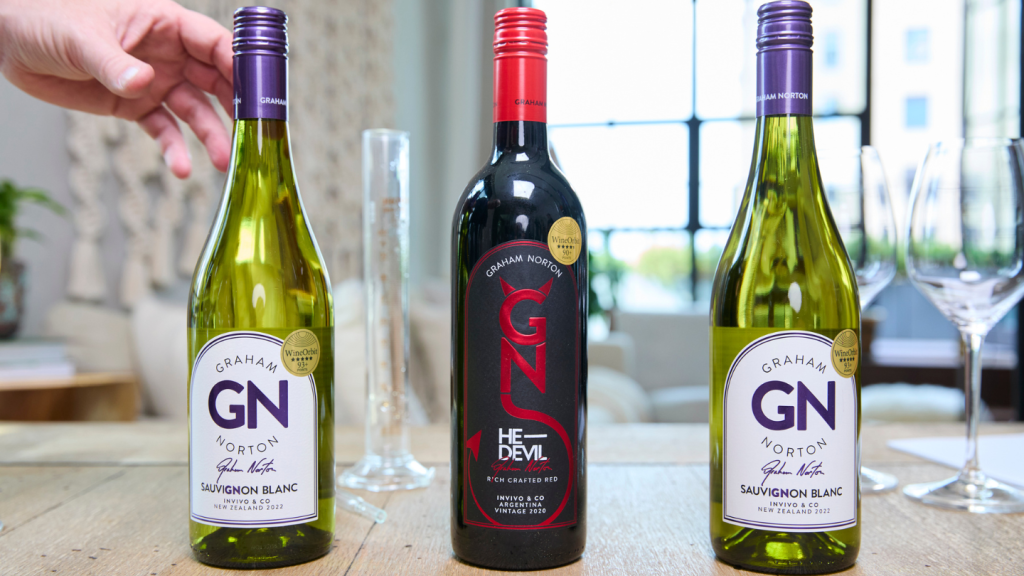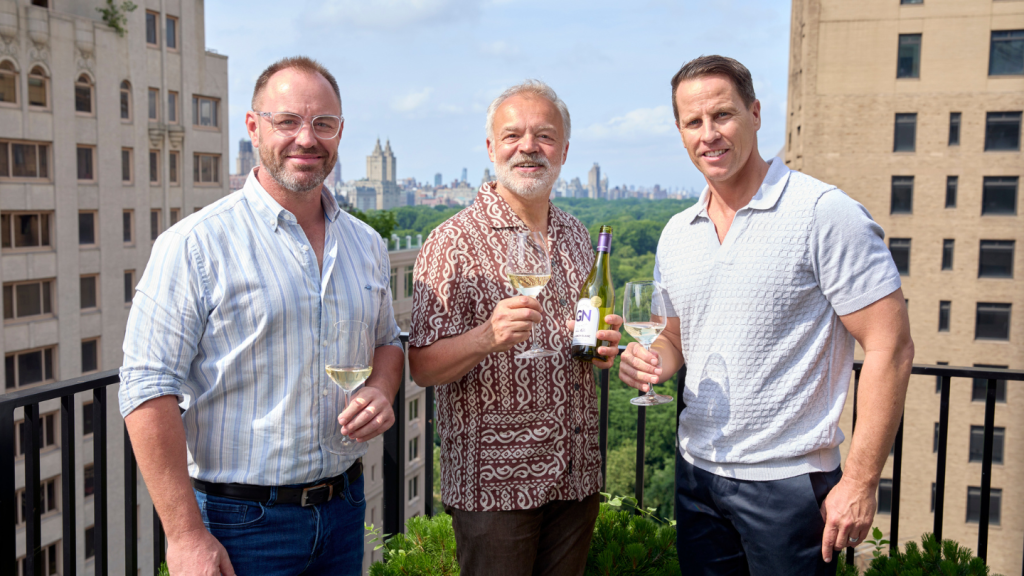Founded in 2008 by Rob Cameron and Tim Lightbourne, New Zealand-based Invivo has recently released its 2024 vintage and held a blending session with television presenter Graham Norton, who has partnered with the winery since 2014.
The business is present in 43 countries in total and works in around 20 vineyards from the north to the south of the country. Its range includes the Graham Norton collection, as the bestseller, as well as a collaboration with American actress Sarah Jessica Parker. It also produces an Invivo collection.
Cameron sat down with Just Drinks to talk about some of the benefits of working closely with well-known celebrities, the future of Sauvignon Blanc in the New Zealand wine scene and the company’s plans to nail the premium pricing “sweetspot”.
Henry Mathieu (HM): How was your recent 2024 harvest?
Rob Cameron (RC): It was a really great quality harvest and a really nice harvest after 2023 which was good as well. Prior to that, we had a couple of tough seasons with a lot of rain and cold. So you know, quality wise, we were ecstatic.
The downside of it was the yields were quite low. So, you know, that has a bit of an effect on quantity but overall we’re thrilled and, when we took the young wines to Graham [Norton], I think he mentioned in our planning sessions that this is probably one of the strongest we’ve seen for a while. I mean, normally he finds wines that he’s not quite aligned with or doesn't like that much. But he made a real point this year of what a fantastic group of wines we had to pick from and blend with. So overall, one of the strongest vintages I would say, as a winemaker, I’ve seen in Marlborough and Hawke’s Bay for the last five or six years.
HM: When you say the yield was down, how substantial was it?
RC: In Hawke’s Bay, we were about 50% or 60% of what we should be. And, to be honest, we’ve had a couple of tough years at Hawke's Bay with a cyclone and just cold weather and so, it’s not unexpected, but the quality is absolutely amazing. So you get the sense of a bittersweet trade-off of great wines but not quite producing enough Invivo.
But Marlborough was exceptional. It was only about 25% down long term average. So, you know, let’s say nothing concerning really, possibly a bit of a blessing in some ways, in terms of keeping the balance of how much Sauvignon Blanc there is out there in the market.
HM: How many wines have you released this year?
RC: So we have our three core brands: Graham Norton is the biggest and then followed by Sarah Jessica Parker and then we also have our Invivo brand across many different varietals, which is more of a home or house-style, winemaker’s selection brand. So there’s three Sauvignon Blancs that we produce across those brands and they’re all very different in style which is kind of the beauty and the fun of it.
What we make for Graham Norton in the UK market majorly is very far removed from the Sarah Jessica Parker brand that goes to the US primarily, or even the Invivo brand that kind of goes a bit everywhere. So, we love the diversity of style that we get to work with Graham and really leverage off his views and opinions and feelings on the wine and that’s part of the magic of the whole process of inviting someone like him to blend because he lives in the UK and obviously loves wine just like many other wine consumers, but how often do you get the opportunity to influence what a big group of people might be able to taste.
I mean, I’m from New Zealand. I’m stuck in my little winery, far be it from me to say, “I think this is what you like.” I love the fact that he says I think we would like this. So it just gives us a little bit more of a closer relationship with our market with our consumers. And that’s everything for us. It’s our whole company.
HM: Whereabouts does the Graham Norton brand perform best?
RC: The UK and Ireland is huge for us. And then we were in Tesco, Morrisons, Budgens, Londis, Ocado in the UK for the Graham Norton range.

But it’s not just the UK. In New Zealand, the He Devil Malbec is the second-biggest and fastest-growing wine in that category. The Shiraz is kicking goals. Sauvignon Blanc is well up there as is the rose. So it's not just New Zealand, but it’s exported to the US. It has a following there and throughout Asia and other parts of Europe so even though it is primarily focused and the volume is in the UK and Ireland, I would say it’s a global brand for sure.
HM: How have you found working with celebrities? What benefits have you seen from collaborations?
RC: I suppose the first thing you know, we don’t really like the idea or the notion of a celebrity wine brand. We’re a wine company that is really good at telling stories in a different way. We produce world-class, top-quality wines, year on year, multiple award-winning, trophies, points, you name it, we’re up there. And so, in our view, how we see it is working and collaborating with the likes of Graham Norton and with Sarah Jessica and allowing them to come into the process, them being involved and engaged in the process.
Then collectively as a genuine collaboration, saying, “How do we get this wine? How do we tell a story to a big audience?” And these people, they’re globally loved and that just gives us a platform to tell our story about actually, what we’re trying to do is create amazing quality wines. Also, we’re quite happy to bust down the normal old-fashioned barriers of what you can or can’t do with wine and focus on trying to connect with people. That wine is about fun. It’s about enjoyment.
We want to cut through all that old wine snobbery and nonsense and these people, Graham and Sarah Jessica, they just help us elevate our platform, elevate our ability to communicate. So we’re not a celebrity wine brand. We’re a wine company that is just real clever with who we partnered with to help us tell our story.
HM: Looking at the New Zealand wine sphere, are you expecting Sauvignon Blanc to continue this trajectory as the frontrunner of the category? Is it time to look for innovation in other varieties or regions?
RC: It’s a big question for sure. You know, we do get ourselves tied up in these knots. I think from time to time, the questions asked internally as an industry, when is the Sauvignon Blanc rush going to go away and I think the reality is, it’s not.
What New Zealand is good at doing is producing good, well-priced, extremely high-quality and fresh Sauvignon Blanc, which is what most countries want to consume, to be honest. And it is a unique position that we have as a country, as a terroir, even across the country, not just Marlborough but from north to south. So I don’t see the demand for that style of wine diminishing, but we just need to ensure that we’re always producing the best quality that we possibly can.
We need to make sure that we unite as an industry to at least control a little bit some of the volume that we produce, so that we are always accessible to a consumer, but it’s going to be premium at the same time. And that’s how we’ve pitched our brands: premium but accessible in that sweet spot of being affordable every day, but certainly not the bottom of the supermarket shelves.
In New Zealand, I think we’ve realised this and we’re just going through a little bit of growing pains and still establishing how we work together collectively to achieve that.
HM: Have inflationary pressures, increasing supply-chain costs and duty hikes affected your pricing strategy?
RC: It’s a great question. Absolutely it’s been very tough the last few years in terms of rising supply chain costs. They are coming down now, which is really good to see. Inflation we can see that easing somewhat. Shipping costs have come right back, although it's still quite a volatile market.
To answer your question, we still are very much in a growth mindset for this brand. So we’re quite aggressive in how we position the brand in all our markets. And when I say aggressive, we're in the sweet spot, but we're not below that. And we still maintain that premium positioning for sure.
HM: What would you say is the “sweet spot” for pricing?
RC: It’s that kind of £7 to £8 ($9 to $10) region. Basically, that seems to be a sustainable price for both consumer and producer as far as we can see. So we can make that work with good volume and deliver great quality.
HM: How has your domestic market performed over the last 18 months?
RC: We’re doing extremely well. But we’ve also had the cost-of-living issues in New Zealand. We’re probably lagging the UK by 12 months, I would say in terms of the hurt so our economy is about the lowest ebb and we’re turning that curve around now. So we’ve had 12 months where it was quite tough trading with some fairly hefty duty increases. And yet we’ve still seen the brands grow by around 15%-plus in the last four months in the local market.
So, you know, we’re actually quite pleased. We feel like we’re in a really good position when the economy bounces back, which it will inevitably. We’re looking for big growth in the next 12 months in Asia.
HM: Looking towards next year’s harvest, are you expecting a bounce back in terms of volume?
RC: I think we will be back to normal. I think we should be expecting normal long-term average harvest volumes out of New Zealand. But I mean, it’s very difficult to say at this stage. Ask me in a couple of months when the flowers have come out and we can have a look then. But yeah, I think that after last year, the cycle would be back to at least normal potential harvest barring frost or anything like that.
HM: Do you have any particular growth targets in mind for the next 12 months?
RC: We’re cautiously optimistic. I won’t give a figure of what we’re expecting to do in comparison to last financial year but things are still challenging out there. The world is still a very uncertain place and what we’ve found is that there’s growth out there, there is business out there that’s going well. It’s very hard to predict, so I’d say it’s a very challenging environment for forecasting and that sort of thing. But overall, we’re cautiously optimistic and we think if a few things go our way then we could have an extremely good year.









